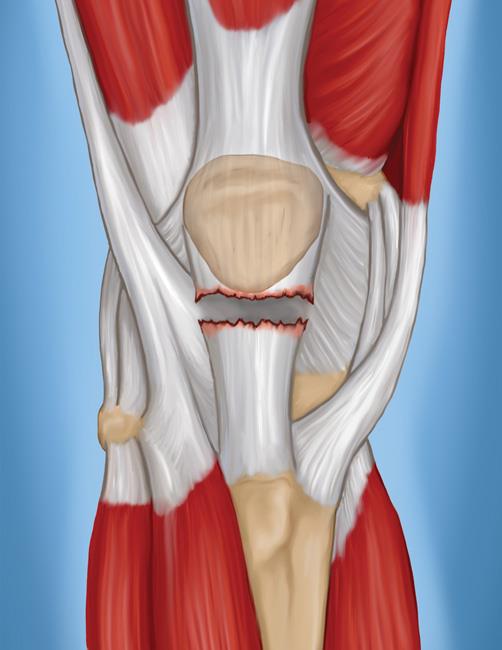Tendons are strong cords of fibrous tissue that attach muscles to bones. The patellar tendon works with the muscles in the front of your thigh to straighten your leg.

Description
Patellar tendon tears can be either partial or complete.
Partial tear: Many tears do not completely disrupt the tendon. This is similar to a rope stretched so far that some of the fibers are frayed, but the rope is still in one piece.
Complete tears: When the patellar tendon is completely torn, the tendon is separated from the kneecap. Without this attachment, you cannot straighten your knee.
Causes:
It takes a very strong force to tear the patellar tendon.
Falls: Direct impact to the front of the knee from a fall or other blow is a common cause of tears. Deep lacerations are often associated with this type of injury.
Jumping: The patellar tendon may tear when the knee is bent and the foot planted, like when landing from a jump or jumping up.
Patellar tendinitis: Inflammation of the patellar tendon, called patellar tendinitis, weakens the tendon. It may also cause small tears.
Steroid use: Using medications like corticosteroids and anabolic steroids has been linked to increased muscle and tendon weakness.
Surgeries: Previous surgery around the tendon, such as a total knee replacement or anterior cruciate ligament reconstruction, might put you at greater risk for a tear.
Symptoms
When a patellar tendon tears, you often experience a tearing or popping sensation. Pain and swelling typically follow, and you may not be able to straighten your knee.
Diagnosis:
Mainly depends on medical History and Physical Examination. followewd by Imaging Tests like X ray anc MRI.
Treatment:
Nonsurgical Treatment:
Very small, partial tears respond well to nonsurgical treatment. Complete tears almost always are treated with surgery.
Surgical Treatment:
Most people with complete patellar tendon tears require surgery to regain knee function. Surgical repair involves reattaching the torn tendon to the kneecap.
People who require surgery do better if the repair is performed soon after the injury. Early repair may prevent the tendon from scarring and tightening into a shortened position.
Recovery: (Refere to Dr. Fahad post op Protocol)
- Most likely, your repair will be protected with a knee immobilizer or, rarely, a long leg cast. You may be allowed to put your weight on your leg with the use of a brace and crutches (or a walker) with your leg in a straight position. To start, Dr. Fahad may recommend "toe touch" weight bearing. This is when you lightly touch your toe to the floor, putting down just the weight of your leg.
- By 2 to 4 weeks, your leg can usually bear about 50% of your body weight.
- After 4 to 6 weeks, your leg should be able to handle your full body weight. In some cases, you can bear weight fully in extension earlier, but it depends on your individual tear, repair, and Dr. Fahad recommendations.
Outcomes:
Most people are able to return to their previous occupations and activities after recovering from a patellar tendon tear. Many people report stiffness in the affected leg, but most regain range of motion nearly equal to that in the uninjured leg.
Referenace: Orthoinfo


